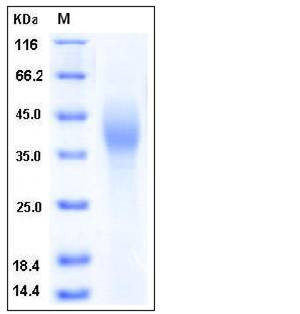Human SLAMF7 / CRACC / CD319 Protein (His Tag)
19A,CD319,CRACC,CS1,SLAM7
- 100ug (NPP3769) Please inquiry
| Catalog Number | P11691-H08H |
|---|---|
| Organism Species | Human |
| Host | Human Cells |
| Synonyms | 19A,CD319,CRACC,CS1,SLAM7 |
| Molecular Weight | The recombinant human SLAMF7 consists of 215 amino acids and has a predicted molecular mass of 23.8 kDa. The apparent molecular mass of rh SLAMF7 is approximately 35-45 kDa in SDS-PAGE under reducing conditions due to glycosylation. |
| predicted N | Ser 23 |
| SDS-PAGE |  |
| Purity | > 93 % as determined by SDS-PAGE |
| Protein Construction | A DNA sequence encoding the human SLAMF7 (NP_067004.3) extracellular domain (Met 1-Met 226) was expressed, fused with a polyhistidine tag at the C-terminus. |
| Bio-activity | Measured by its ability to bind biotinylated human SLAMF7 in a functional ELISA. |
| Research Area | Immunology |Signal Transduction |ITIM/ITAM Immunoreceptors and Related Molecules |
| Formulation | Lyophilized from sterile PBS, pH 7.4 1. Normally 5 % - 8 % trehalose, mannitol and 0.01% Tween80 are added as protectants before lyophilization. Specific concentrations are included in the hardcopy of COA. |
| Background | SLAM family member 7 (SLAMF7), also known as CRACC, CD319, CD2-like receptor-activating cytotoxic cells, and CS1, is a single-pass type I membrane protein and a member of the CD2 family of cell surface receptors. SLAMF7 is expressed in NK cells, activated B-cells, NK-cell line but not in promyelocytic, B-cell lines, or T-cell lines. Although the cytoplasmic domain of CS1 contains immunoreceptor tyrosine-based switch motifs (ITSM), which enables to recruite signaling lymphocyte activation molecule (SLAM)-associated protein (SAP/SH2D1A), it activates NK cells in the absence of a functional SAP. CS1 is a self ligand and homophilic interaction of CS1 regulates NK cell cytolytic activity. CRACC positively regulated natural killer cell functions by a mechanism dependent on the adaptor EAT-2 but not the related adaptor SAP. However, in the absence of EAT-2, CRACC potently inhibited natural killer cell function. It was also inhibitory in T cells, which are typically devoid of EAT-2. Thus, CRACC can exert activating or inhibitory influences on cells of the immune system depending on cellular context and the availability of effector proteins. |
| Reference |
